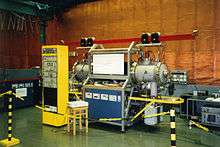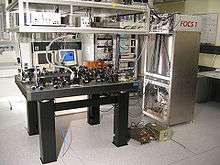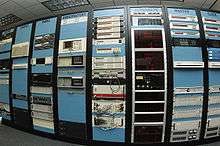List of atomic clocks
This is a list of some experimental laboratory atomic clocks worldwide.
This list is incomplete; you can help by expanding it.
References
- ↑ "Seit wann läuft die erste Atomuhr in der PTB?". Themenrundgänge / Fragen zur Zeit. Physikalisch-Technische Bundesanstalt. Retrieved 2013-02-04.
- ↑ Palmer, Jason. "UK's atomic clock 'is world's most accurate'". BBC. Retrieved 2013-03-02.
- ↑ "Research - Time and Frequency". Retrieved 2015-06-12.
- ↑ "A Brief History of Atomic Clocks at NIST". The National Institute of Standards and Technology (NIST). Retrieved 2013-02-04.
- ↑ "NIST Launches a New U.S. Time Standard: NIST-F2 Atomic Clock". The National Institute of Standards and Technology (NIST). Retrieved 2016-02-09.
- ↑ Newman, Michael E. (1999-12-29). "NIST-F1 Cesium Fountain Clock". NIST News. The National Institute of Standards and Technology (NIST). Retrieved 2013-02-04.
- ↑ "U.S. Naval Observatory Alternate Master Clock". U.S. Navy. Retrieved 2013-02-09.
- ↑ "Mission of Japan Standard Time Group - Generation of Japan Standard Time (JST)". National Institute of Information and Communications Technology. Retrieved 2013-03-05.
- ↑ Motal, Julius (2011-08-30). "Japanese atomic clock is accurate to a 100 quadrillionth of a second". Geek.com. Ziff Davis, Inc. Retrieved 2013-03-02.
- ↑ "Quantum Metrology Laboratory". RIKEN Advanced Science Institute. Retrieved 2013-03-05.
- ↑ Takamizawa, A.; Yanagimachi, S.; Shirakawa, Y.; Watabe, K.; Hagimoto, K.; Ikegami, T., "Cesium Atomic Fountain Clocks at NMIJ" (PDF), Precise Time and Time Interval Systems and Applications Meeting, pp. 321–328
- ↑ Wang, Yuanyuan (2012-07-12). "China unveils first optical clock". English News. Xinhuanet. Retrieved 2013-02-04.
- ↑ "Caesium Beam Atomic Clock". The Government of the Hong Kong Special Administrative Region. Retrieved 2013-02-14.
- ↑ "History of Hong Kong Time Service". The Government of the Hong Kong Special Administrative Region. Retrieved 2013-02-11.
- ↑ "Contact us". The Government of the Hong Kong Special Administrative Region. Retrieved 2013-02-11.
- ↑ "Clocks and Time scales". National Time and Frequency Standard Laboratory. Retrieved 2013-02-14.
- ↑ "Current activities of the National Standard Time and Frequency Laboratory of the Telecommunication Laboratories" (PDF). Retrieved 2013-02-14.
- ↑ "Development of Korea's First Primary Frequency Standard, 'KRISS-1'" (PDF). KRISS. Retrieved 2013-03-01.
- ↑ Lee, Ho Seong; Kwon, Taeg Yong; Park, Sang Eon; Choi, Sang-Kyung; Park, Young-Ho (August 2004). "Research on Cesium Atomic Clocks at the Korea Research Institute of Standards and Science". Journal of the Korean Physical Society. 45 (2): 256–272. Retrieved 2013-03-06.
- ↑ "About SST". National Metrology Centre. Retrieved 2013-03-01.
- ↑ Shoba, V (2008-12-28). "Why time will stop". The Indian Express. The Indian Express ltd. Retrieved 2013-02-04.
- ↑ "With PST, "Filipino time" is now "on time"". Department of Science and Technology. Retrieved 2014-06-07.
- ↑ "Time Standard". Indonesian Institute of Sciences. Retrieved 2016-06-22.
- ↑ "Deep Space Atomic Clock". NASA's Jet Propulsion Laboratory. NASA. 27 April 2015. Retrieved 2015-10-28.
This article is issued from Wikipedia - version of the 8/25/2016. The text is available under the Creative Commons Attribution/Share Alike but additional terms may apply for the media files.




